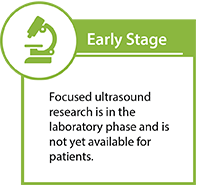Focused Ultrasound Therapy
Focused ultrasound is a noninvasive, therapeutic technology with the potential to improve the quality of life and decrease the cost of care for patients with ventricular tachycardia. This novel technology focuses beams of ultrasound energy precisely and accurately on targets deep in the body without damaging surrounding normal tissue.
How it Works
Where the beams converge, focused ultrasound can produce precise ablation (thermal destruction) of the malfunctioning tissue that is causing the ventricular tachycardia. Another option is to ablate the stellate ganglion, as this elevates the threshold for ventricular fibrillation. Both of these steps are accomplished noninvasively. These preclinical projects have been recently accomplished, but it will take further studies before clinical use can occur.
Advantages
The primary options for treatment of ventricular tachycardia include medication and invasive surgical procedures.
For certain patients, focused ultrasound could provide a noninvasive alternative to surgery with less risk of complications – such as surgical wound healing or infection – at a lower cost. Focused ultrasound can also reach the desired target without damaging surrounding tissue, and it can be repeated, if necessary.
Clinical Trials
At the present time, there are no clinical trials recruiting patients for focused ultrasound treatment of ventricular tachycardia.
Regulatory Approval and Reimbursement
Focused ultrasound treatment for ventricular tachycardia is not yet approved by regulatory bodies or covered by medical insurance companies.
Notable Papers
Xiang C, Cheng Y, Yu X, Mao T, Luo H, Hu H, Wu Y, Sang R, Wang Z, Wang Y, Luo Q, Huang J, Zhao J, Wang J, Wang X, Chen M, Liu W, Zhou L, Wang S, Jiang H. Low-intensity focused ultrasound modulation of the paraventricular nucleus to prevent myocardial infarction-induced ventricular arrhythmia. Heart Rhythm. 2023 Nov 30:S1547-5271(23)02976-4. doi: 10.1016/j.hrthm.2023.11.026. PMID: 38042443
Wang S, Li B, Li X, Wu L, Zhu T, Zhao D, Jiang H. Low-intensity ultrasound modulation may prevent myocardial infarction induced sympathetic neural activation and ventricular arrhythmia. J Cardiovasc Pharmacol. 2020 Feb 17. doi: 10.1097/FJC.0000000000000810.
Yao Y, Qian J, Rong S, Huang Y, Xiong B, Yang G, Zhang D, Deng S, Tan J, Zhu Q, Deng C, Liu D, Ran H, Wang Z, Huang J. Cardiac Denervation for Arrhythmia Treatment with Transesophageal Ultrasonic Strategy in Canine Models. Ultrasound Med Biol. 2019 Feb;45(2):490-499. doi: 10.1016/j.ultrasmedbio.2018.10.013. Epub 2018 Dec 6.
Lü F, Huang W, Benditt DG. A feasibility study of noninvasive ablation of ventricular tachycardia using high-intensity focused ultrasound. J Cardiovasc Electrophysiol. 2018 May;29(5):788-794. doi: 10.1111/jce.13459. Epub 2018 Mar 6.
Bessiere F, N’djin WA, Colas EC, Chavrier F, Greillier P, Chapelon JY, Chevalier P, Lafon C. Ultrasound-Guided Transesophageal High-Intensity Focused Ultrasound Cardiac Ablation in a Beating Heart: A Pilot Feasibility Study in Pigs. Ultrasound Med Biol. 2016 Aug;42(8):1848-61. doi: 10.1016/j.ultrasmedbio.2016.03.007. Epub 2016 May 2.
Nazer B, Salgaonkar V, Diederich CJ, Jones PD, Duggirala S, Tanaka Y, Ng B, Sievers R, Gerstenfeld EP. Epicardial Catheter Ablation Using High-Intensity Ultrasound: Validation in a Swine Model. Circ Arrhythm Electrophysiol. 2015 Dec;8(6):1491-7. doi: 10.1161/CIRCEP.115.003547. Epub 2015 Nov 6.
Click here for additional references from PubMed.

